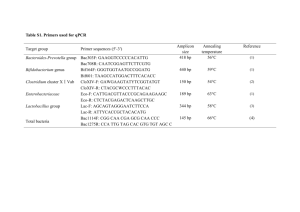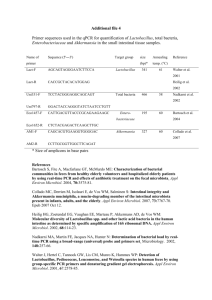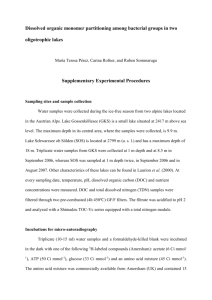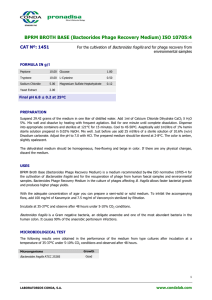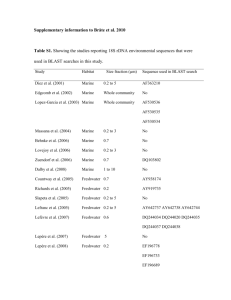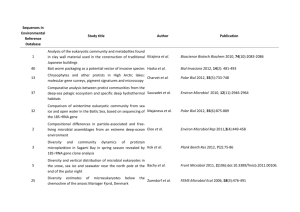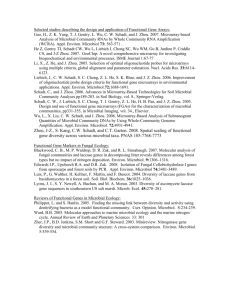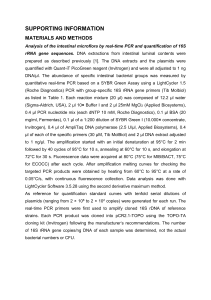1 brought to you by www.thebacteriophages.org and www.phage
advertisement
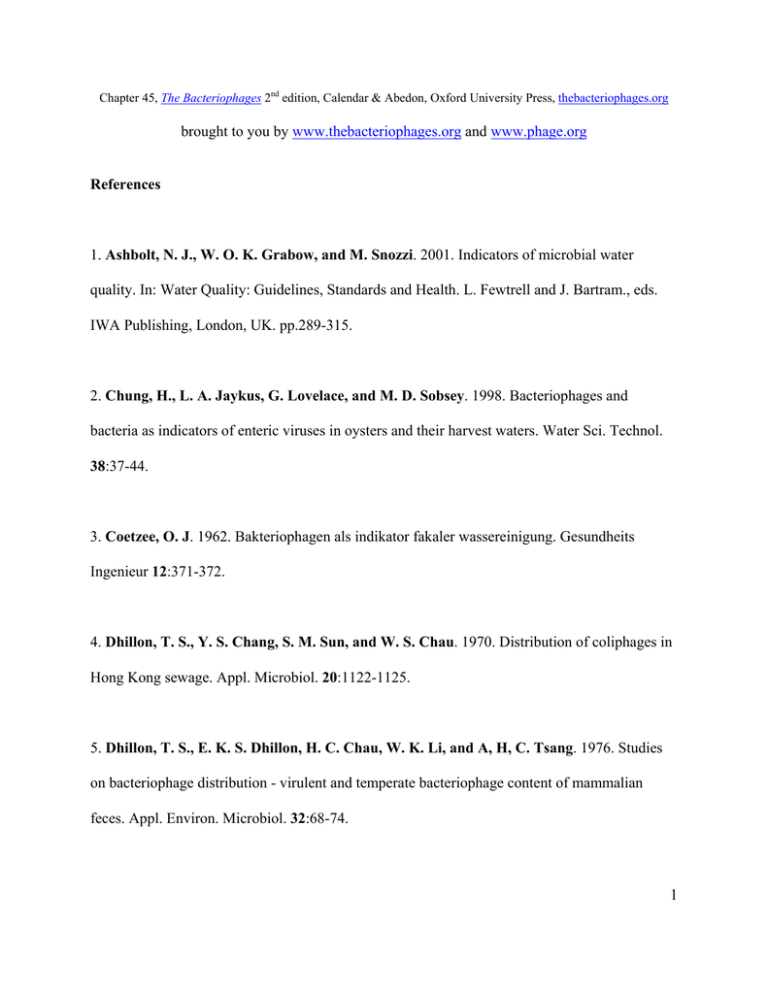
Chapter 45, The Bacteriophages 2nd edition, Calendar & Abedon, Oxford University Press, thebacteriophages.org brought to you by www.thebacteriophages.org and www.phage.org References 1. Ashbolt, N. J., W. O. K. Grabow, and M. Snozzi. 2001. Indicators of microbial water quality. In: Water Quality: Guidelines, Standards and Health. L. Fewtrell and J. Bartram., eds. IWA Publishing, London, UK. pp.289-315. 2. Chung, H., L. A. Jaykus, G. Lovelace, and M. D. Sobsey. 1998. Bacteriophages and bacteria as indicators of enteric viruses in oysters and their harvest waters. Water Sci. Technol. 38:37-44. 3. Coetzee, O. J. 1962. Bakteriophagen als indikator fakaler wassereinigung. Gesundheits Ingenieur 12:371-372. 4. Dhillon, T. S., Y. S. Chang, S. M. Sun, and W. S. Chau. 1970. Distribution of coliphages in Hong Kong sewage. Appl. Microbiol. 20:1122-1125. 5. Dhillon, T. S., E. K. S. Dhillon, H. C. Chau, W. K. Li, and A, H, C. Tsang. 1976. Studies on bacteriophage distribution - virulent and temperate bacteriophage content of mammalian feces. Appl. Environ. Microbiol. 32:68-74. 1 Chapter 45, The Bacteriophages 2nd edition, Calendar & Abedon, Oxford University Press, thebacteriophages.org 6. Dore, W. J., K. Henshilwood, and D. N. Lees. 2000. Evaluation of F-specific RNA bacteriophage as a candidate human enteric virus indicator for bivalue molluscan shellfish. Appl. Environ. Microbiol. 66:1280-1295. 7. Furuse, K. 1987. Distribution of coliphages in the environment: general considerations. In: S. M. Goyal, C. P. Gerba, and G. Bitton, eds., Phage Ecology. Wiley and Sons. NY. pp. 87124. 8. Furuse, K., A. Ando, S. Oswa, and I. Wantanabe. 1981. Distribution of ribonucleic acid coliphages in raw sewage in South and East Asia. Appl. Environ. Microbiol. 41:995-1002. 9. Gantzer, C., J. Henry, and L. Schwartzbrod. 2002. Bacteroides fragilis and Escherichia coli bacteriophages in human feces. Int. J. Hyg. Environ. Hlth. 205:325-328. 10. Gantzer, C., A. Maul, J. M. Audic, and L. Schwartzbrod. 1998. Detection of infectious enteroviruses, enterovirus genomes, somatic coliphages, and Bacteroides fragilis phages in treated wastewater. Appl. Environ. Microbiol. 64:4307-43012. 11. Geldreich, E. E. 1978. Bacterial populations and indicator concepts in feces, sewage, stormwater and soil wastes. In: Indicators of Viruses in Water and Food. G. Berg, ed. Ann Arbor Science. Ann Arbor, MI pp 51-98. 2 Chapter 45, The Bacteriophages 2nd edition, Calendar & Abedon, Oxford University Press, thebacteriophages.org 12. Gerba, C. P. 1987. Phage as indicators of fecal pollution. In: S. M. Goyal, C. P. Gerba, and G. Bitton. Phage Ecology. Wiley and Sons, NY. pp.197-210. 13. Griffin, D. W., R. Stokes, J. B. Rose, and J. H. Paul. 2000. Bacterial indicator occurrence and the use of an F(+) specific RNA coliphage assay to identify fecal sources in Homosassa Springs, Florida. 14. Havelaar, A. H. 1993. A Bacteriophage Standard for Bathing Beaches. final Report. National Institute of Public Health and Environmental Protection. Bilthoven, The Netherlands. 15. Havelaar, A. H. 1993b. Bacteriophages as models of human enteric viruses in the environment. ASM News. 59:614-619. 16. Havelaar, A. H., K. Furuse, and W. M. Hogeboom. 1986. Bacteriophages and indicator bacteria in human and animal feces. J. Appl. Bacteriol. 60:255-262. 17. Havelaar, A. H., and W. M. Hogeboom. 1984. A method for the enumeration of coliphages in sewage and sewage-polluted waters. Antonie van Leeuwenhoek 49:387-397. 18. Havelaar, A. H., W. M. Hogeboom, and R. Pot. 1984. F-specific RNA bacteriophages in sewage: methodology and occurrence. Water Sci. Technol. 17:645-655. 3 Chapter 45, The Bacteriophages 2nd edition, Calendar & Abedon, Oxford University Press, thebacteriophages.org 19. Havelaar, A. H., M. Olphen, Y. C. Olphen, and Y. C. van Dorst. 1993. F-spedific RNAbacteriophages are adequate model organisms for enteric viruses in fresh water. Appl. Environ. Microbiol. 59:2956-2962. 20. Havelaar, A. H., and W. M. Pot-Hogeboom. 1988. F-specific RNA-bacteriophages as model viruses in water hygiene: ecological aspects. Water Sci. Technol. 20:399-407. 21. Havelaar, A. H., W. M. Pot-Hogeboom, K. Furuse, R. Pot, and M. P. Hormann. 1990. Fspecific RNA bacteriophages and sensitive host strains in feces and wastewater of human and animal origin. J. Appl. Bacteriol. 69:30-37. 22. Hsu, F. C., Y. S. Shieh, J. van Duin, M. J. Beekwilder, and M. D. Sobsey. 1995. Geneotyping male-specific RNA coliphages by hybridization with oligonucleotide probes. Appl. Environ. Microbiol. 61:3960-3966. 23. IAWPRC Study Group on Health Related Water Microbiology. 1991. Bacteriophages as model viruses in water quality control. Water Res. 25:529-545. 24. ISO.1995. International Organization for Standardization. Water Quality. Detection and Enumeration of Bacteriophages-Part 1: Enumeration of F-specific RNA Bacteriophages. ISO/DIS10705-1. Geneva, Switzerland. 4 Chapter 45, The Bacteriophages 2nd edition, Calendar & Abedon, Oxford University Press, thebacteriophages.org 25. ISO.1999. International Organization for Standardization. Water Quality. Detection and Enumeration of Bacteriophages-Part 2. Enumeration of Bacteriophages Infecting Bacteroides fragilis. ISO/DIS10705-4. Geneva, Switzerland. 26. Jiang, S., R. Noble and W. Chu. 2001. Human adenoviruses and coliphages in urban runoff-impacted coastal waters of Southern California. Appl. Environ. Microbiol. 67:179-184. 27. Jofre, J. 2002. Bacteriophage indicators. In: Encyclopedia of Environmental Microbiology. G. Bitton, ed. John Wiley and Sons, NY. pp 354-363. 28. Jofre, J., M. Blasi, A. Bosch, and F. Lucena. 1989. Occurrence of bacteriophages infecting Bacteroides fragalis and other viruses in polluted marine sediments. Water Sci. Technol. 21:1519. 29. Jofre, J., A. Bosch, R. Lucena, R. Girones, and C. Tartera. 1986. Evaluation of Bacteroides fragilis bacteriophages as indicators of the virological quality of water. Water Sci. Technol. 18:167-173. 30. Kai, S., S. Wantanabe, K. Furuse and A. Furuse, and A. Osawa. 1985. Bacteroides bacteriophages isolated from human feces. Microbiol. Immunol. 29:895-899. 31. Kott, Y. 1966. Estimation of low numbers of Escherichia coli bacteriophage by use of the 5 Chapter 45, The Bacteriophages 2nd edition, Calendar & Abedon, Oxford University Press, thebacteriophages.org most probable number method. Appl. Microbiol. 14:141-144. 32. Leclerc, H., S. Edberg, V. Pierzo, and J. M. Delattre. 2000. Bacteriophages as indicators of enteric viruses and public health risk in groundwaters. J. Appl. Microbiol. 88:5-21. 33. Osawa, S., K. Furuse and I. Watanabe. 1981. Distribution of ribonucleic acid coliphages in animals. Appl. Environ. Microbiol. 41:164-168. 34. Puig, A., N. Queralt, J. Jofre and R. Araujo. 1999. Diversity of Bacteroides fragilis strains in their capacity to recover phages from human and animal wastes and from fecally polluted wastewater. Appl. Environ. Microbiol. 65:1772-1776. 35.Stetler, R. E. 1984. Coliphages as indicators of enteroviruses. Appl. Environ. Microbiol. 48:668-670. 36. Tartera, C., and J. Jofre. 1987. Bacteriophages active against Bacteroides fragilis in sewage-polluted waters. Appl. Environ. Microbiol. 24:1632-1637. 37. Woody, M. A., and D. O. Cliver. 1997. Replication of coliphage Q beta as affected by host cell number, nutrition, competition from insusceptible cells and non-FRNA coliphages. J. Appl. Microbiol. 82:431-440. 6
